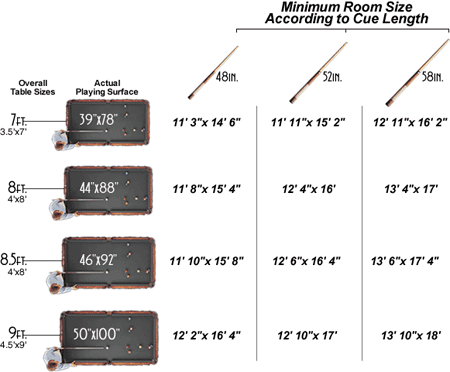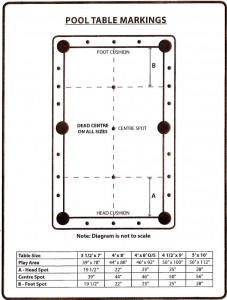Congratulations! You’ve finally decided to get a pool table! Now, you just need to know how big of a table you can get to fit in the room where you want it. After all, you don’t want this happening to you:
Get Your Room Dimensions
The first thing you want to is to get your room dimensions. Be sure to account for anything that could get in the way while playing. Things like pillars, fireplace mantles, or shelves protruding from the wall can obstruct your play. Also, if you’re planning on decking out the entire room, other furniture you put in there will reduce the overall space for your pool table. One other factor to consider is to ensure you have space for lighting above the table.
Room Size for a Pool Table
The room size you need for a pool table also depends on the length of the cue you’ll be using. The standard cue length is 58 inches, but there are shorter options available if you’re tight on space. It may feel a bit uncomfortable to use a shorter cue though if you’re used to playing with 58 inch cues elsewhere. Here are the minimum room sizes for different size pool table and different length cues.

If you don’t want to remember these specific numbers, the rough rule of thumb is that you want at least 5 feet around the pool table in all directions. So, if you’re shopping for an 8-ft pool table (roughly 4 x 8 ft), you need approximately 14 x 18 ft of room. The nitty gritty calculation is that the 58 inch cue length is added to each side around the playing surface, so for an 8-ft table, it’s:
- 44+58+58 x 88+58+58, or;
- 160 x 204 inches (13’ 4” x 17’).
This recommendation, however, only means that the cue itself will be level if the cue ball is right up against the rail and you need to shoot straight out from the rail. It doesn’t actually account for the need for a backswing when you’re actually shooting the ball, so you will still need to elevate the cue a little bit if you’re facing this shot. And for trick shots, this measurement doesn’t account for the fact that sometimes the cue ball will start on top of the rail!
Standard or Regulation Pool Table Sizes
As you see above, pool tables come in various sizes, named 7-ft, 8-ft, 8.5-ft, and 9-ft. However, using the terms “standard” or “regulation” pool table doesn’t specify the table size. It really only means that the playing surface of the table is twice as long as it is wide. The World Pool-Billiard Association (WPA), the governing body of pool, only sanctions tournaments on 8.5-ft or 9-ft pool tables, so one could consider that to be “regulation”.
The naming convention is a little tricky, but here’s my best explanation at it. The playing area is the surface between the noses of the cushions. From the small width, they add 4 inches to cover the width underneath the cushions. With the exception of the oversized 8 foot table, this brings all of the short dimensions to the proper measurement in feet. Then they just tack on the proper 1:2 ratio to get the long length and the number that is usually referred to.
The exterior dimensions of the table depend on the width of the rails and cushions. Officially, the total width is specified to be between 4 and 7-1/2 inches. Commercial style tables will typically be on the wider end while home style tables will be narrower. This can affect how well you can make a bridge on the rail if the cue ball is close to the cushion.
The 7 foot pool table is often referred to as a “bar box” because this is typically the size found in bars and pubs. Most home tables tend to be 8 foot. High level tournaments generally use 9 foot pool tables. For real cheap thrills, there are also 6 foot tables available, but these are very low quality.
Most trick shots can be made on any size pool table. They will take a little adjusting going between sizes and certain shots will definitely be easier on certain size tables.
UK Pool Tables
UK pool tables are measured by their exterior dimensions and are usually 4 x 7 ft or 3 x 6 ft. Therefore, using the “rule of thumb” calculation will actually overestimate your needed space to play comfortably. Regardless, they still have a 1:2 ratio for the playing area, so most trick shots should transfer as far as the angles are concerned.
Also, the rails on UK pool tables have rounded corners going in to the pocket. This makes it so the pockets don’t accept balls as easily, especially with balls traveling straight down the rail. In trick shots, this can be accommodated for by placing a small row of balls or a triangle coming out from one of the corners of the pocket to help guide the object ball in.
Finally, snooker tables have a playing surface of 70 x 140.5 inches, typically referred to as 6 x 12 feet. Obviously, you’ll need an even bigger room to fit these. Smaller snooker tables are available as well if you’re short on space. The larger size can eat up a lot of the roll of the balls too.
Pool vs Billiards
While most Americans will be familiar with the pool table that has six pockets, billiard tables are pocketless tables used for games of carom billiards. These tend to be 5 x 10 feet with a playing surface of 56 x 112 inches, although the Korean version is 4.5 x 9 feet, like a pro pool table. The calculation for room size is similar though, so figure roughly 15 x 20 feet of space for the larger billiard table.
